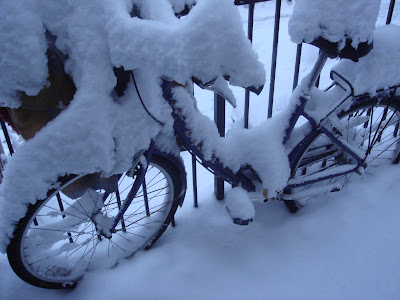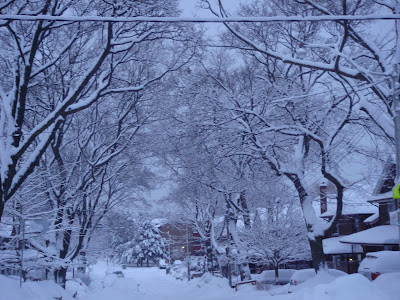There's even an etiquette that goes along with Winter Weather, involving such details as who should step to the side when two people are walking toward each other on an un-shovelled footpath.

These pictures were taken in the early morning, which is why the light looks blue-ish and slightly dim. The snow had hardly stirred since it fell the night before. I always love going out right after a storm, whether in the middle of the night or as in this case, just after dawn (which of course comes later in the winter). The best snow is of the kind you can see here, the very fluffy and damp variety that sticks well to objects and to itself, forming piles perched on power lines, fences and other narrow areas (like the bike pictured above). This kind of snow is perfect for rolling into snowballs and for building snow-sculptures of all kinds, since it "packs" perfectly and stays in shape.
I think this is the kind of snow I always imagined as archetypal, as a child growing up in an area where snow falls only a couple of times in a century.

The nicest thing about snow before it's sullied is that it's easier to enjoy it: there's no slush yet, because the temperature may not have dropped low enough and because there's no salt on the roads and the footpaths. Not enough cars have driven by to create the churned, soupy and gritty muck that pools in the gutters after rush hour on mornings like the one pictured here. The footpaths are easily navigable because the snow hasn't yet been squashed into a slippery, lumpy sheet by the pressure of many feet taking the easiest path through. And everything looks somehow cleaner, and fresh, and there's an air of the fairytale-eque as if each house might be made of ginger-bread beneath its snowy mantle.

The other thing is that the weather is usually quite lovely right at this time, right before the snow melts or freezes to ice, when the air is just so--slightly damp and hovering around zero. There's often no wind, and it's the perfect time for a crunchy stroll after being cooped up during a storm.
This is snow showing some of its best effects, when it's fallen upon itself time and time again and slowly eroded the forms of what lies beneath it, creating mysterious lumps and bumps and also practical problems for the uninitiated--such as mis-guessing where the concrete edge of the gutter might be, and slipping or jolting forward onto the road. It brings a kind of equalising effect, bridging the fir tree and the power line, like the same batch of icing spread over many differently-shaped cookies.

*Yes, I'm well aware that snow does not play the same role in, say, Vancouver, as it does in Montreal. And yet there is still a kind of amusing regional dynamic that emerges, with those living on the West Coast always keen to announce the arrival of daffodils in March, knowing all the while that in Ottawa, an ice storm might have hit the night before. Another example of this is the way in which Toronto was mocked throughout the rest of the country for calling in the army to clear snow after a series of severe storms.
No comments:
Post a Comment